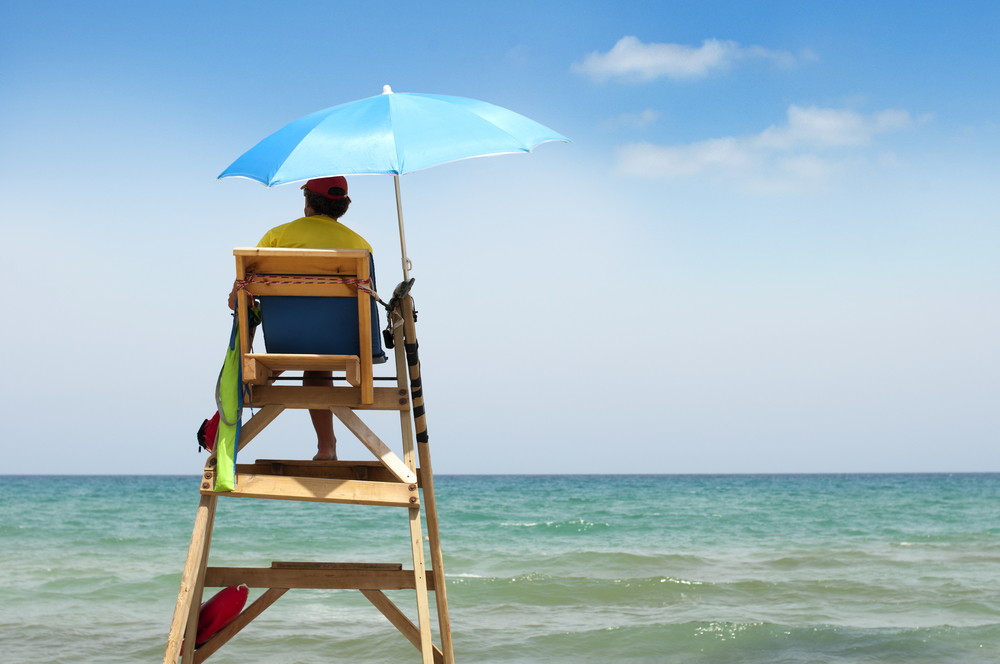
Deyan Georgiev / Shutterstock.com
Beach getaways for spring break and summer vacation are a favorite tradition of many families and friend groups around the world. There’s nothing like having the sand between your toes, the sun on your face, and the smell of sunscreen and surf in the air. Beaches can be a dangerous place, however. CDC statistics show that in the United States alone, over 3,500 people drown each year, many of these a result of alcohol intoxication. So, before you pack up and head to Cancún, Maui, or Panama City, there are a few things you should keep in mind.
Check the forecast.
Just because the water looks calm doesn’t mean that it actually is. The National Weather Service has offices along the U.S. coasts that issue forecasts for rain, lightning, temperature, and wind, but also the risk of rip currents and the UV index.
The UV index is a measurement of the sun’s rays and indicates how long it would take a person to burn without sunscreen. A low UV index means that it would take a long time to burn. A high UV index means that it could take as little as 10 minutes.

paultarasenko / Shutterstock.com
Wear sunscreen.
Even if the UV index is low, you should still apply sunscreen to exposed skin. Look for a broad spectrum sunscreen (one that blocks both UVA and UVB rays) and has a sun protection factor (SPF) of at least 30. If you’re planning on swimming or sweating, looking for a sunscreen that is also water and sweat resistant is a plus. Sunscreen should be initially applied at least 15 minutes before sun exposure and reapplied every two hours or after swimming.
Sunscreen helps prevent skin cancer (caused by the sun’s UVA and UVB rays), keeps your skin looking younger for longer, and prevents painful sunburns. Repeated bad sunburns can also increase your risk of developing skin cancer.
Learn what warning flags mean.
Typically, green means go and red means stop, but the colors and placement of flags may differ depending on what beach you’re visiting. If the flags indicate that it is unsafe to enter the water, do not enter the water. Play beach volleyball or visit a different, safer beach instead. If the flags indicate that the beach is open, still be careful and aware that conditions can change suddenly.
Beware of rip currents.
A rip current (often incorrectly referred to as a rip tide) is a powerful, narrow channel of water that can flow as fast as eight feet per second. Generally, they flow perpendicular to the shoreline. Though they are strong, they are also small, meaning that if you keep your wits about you, you can swim out of a rip current without drowning as a result of fatigue or being pulled too far out to sea.
- Don’t panic. Try to stay calm. If you panic and begin to flail, you’re putting yourself at a much higher risk for drowning.
- Don’t fight a rip current. Swimming against the current will only serve to exhaust you. Michael Phelps, an Olympic swimmer, only goes about six and a half feet per second when he’s racing, so unless you are better than Michael Phelps, you cannot outswim a rip current. Instead, float, let the current draw you away from the shore, and call for attention.
- Swim parallel to shore. If you are a strong swimmer, try swimming parallel to shore. Rip currents are narrow, so you should be able to make it out of the current and into normal water without getting too exhausted. Once you’re out of the current, swim toward the shore. The waves will help get you closer too.
Avoid alcohol.

Rawpixel.com / Shutterstock.com
Not only is it illegal for people under the age of 21 to purchase or consume alcohol, but drinking at the beach can have some pretty negative side effects. For one, you will dehydrate way more easily than if you were drinking water or juice. Secondly, alcohol dulls your senses, impairs your reaction time, and can make you pretty clumsy in the water, making drowning much more of a possibility than it would be otherwise. Not only that, but should you need to be rescued, being intoxicated makes it less likely that CPR will be effective.
Some beaches, like Gulf Shores in Alabama, have voted for bans on alcohol at the beach during spring break. Since travelling to the Gulf of Mexico has become a popular spring break event for college students, alcohol consumption during spring break has climbed. This dangerous and unappealing to other visitors, and it can be dangerous for the students.
Do not approach wildlife.
Wild animals are not your friends, and by swimming at the beach, you are trespassing on their territory, not the other way around. In addition to the big threats that may be present at coastal beaches (jellyfish, sharks), you should always watch out for stingrays, sea urchins, lionfish, and lost alligators. Never approach, pick up, or try to interact with sea creatures.
- If you are stung by a jellyfish, you should first alert a lifeguard. Some jellyfish stings can be fatal if not treated immediately (a box jellyfish, for example). A lifeguard may be able to provide any treatment necessary or call emergency services to bring any necessary antivenom.
- If there is no lifeguard present, you should rinse the affected area with ocean water and scrape off any visible stingers with a credit card. You could also rinse the area with vinegar and apply a paste made up of baking soda and ocean water to the area.
- Urinating on the affected area is not necessary and not recommended by doctors.
- If you end up in an altercation with a shark, defend yourself in any way possible. A shark’s eyes and nose are sensitive, so focus your attack there. If the shark bites you, you may be fighting for your life. Try to scratch out its eyes. If the shark lets go, try to get out of the water immediately and stop the bleeding. Get emergency help as soon as possible.
- If a shark has been sighted, do not enter the water. If one has been sighted once you are already in the water, get to shore as quickly and calmly as you can.
- Watch for warning signs and take the appropriate precautions.
- Don’t swim at dawn, dusk, or night.
- Don’t swim in water you can’t see through or in areas with deep drop offs.
- Thrashing around and swimming with animals who move erratically may draw the attention of sharks.
- Remove reflective jewelry and avoid wearing bright clothing, both of which are attractive to sharks.
- When other animals are leaving the water or behaving strangely, take their cues and get out. Birds may raise a fuss or stop landing on the ocean surface when there is a threat.
- Under no circumstances should you remove any sort of wildlife from the water for the sake of photographs or to cause it any harm. Many sea creatures are protected or endangered and intentionally hurting or killing them can result in an investigation, fine, or jail time.
Be beach smart.
- Know how to swim.
- Don’t swim alone.
- Swim at beaches with lifeguards.
- Stay hydrated.
-
Six Yoga Poses to Help with Anxiety and Panic Attacks
-
How to Keep Your Brain Active Over Summer Vacation
-
Summer Side Gigs for Teachers
-
The Truth: Why You Should Get Fit to Finish the School Year
-
Do This, Not That: The Summer Before College
-
Preparing for a Summer Music Festival
-
Cómo aprovechar un viaje corto para mejorar un idioma
-
Beachy Reads: Your Perfect Summer Reading List
-
10 Spring Break Safety Tips
-
Ten Things You Should Accomplish the Summer Before College
-
How to Be Smart in Our National Parks This Summer
-
Five Tips to Help You Save Money this Summer

